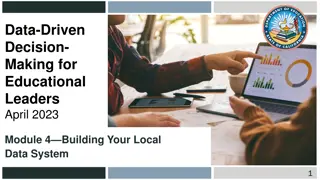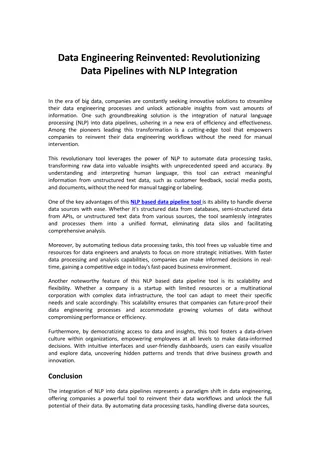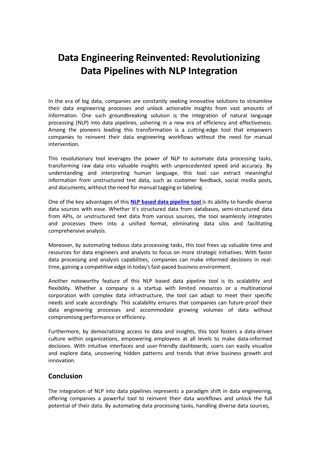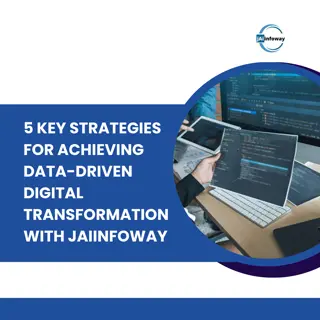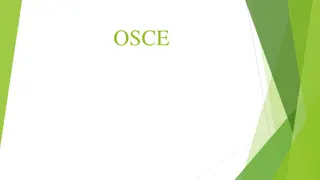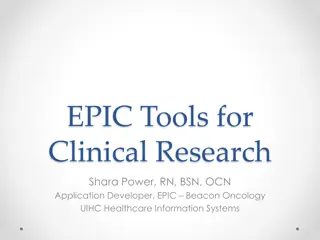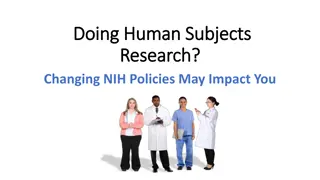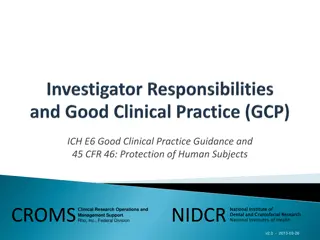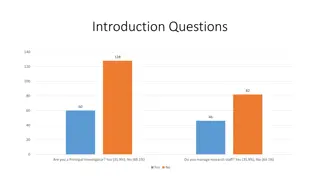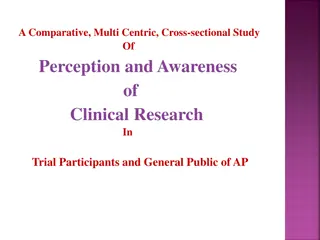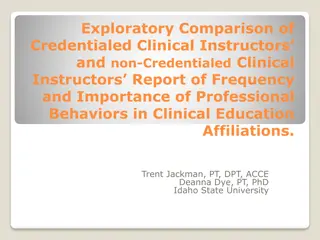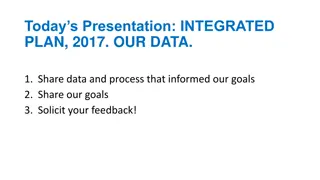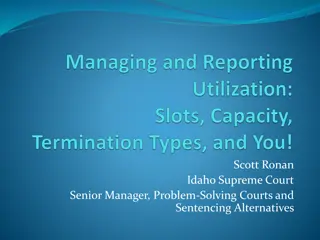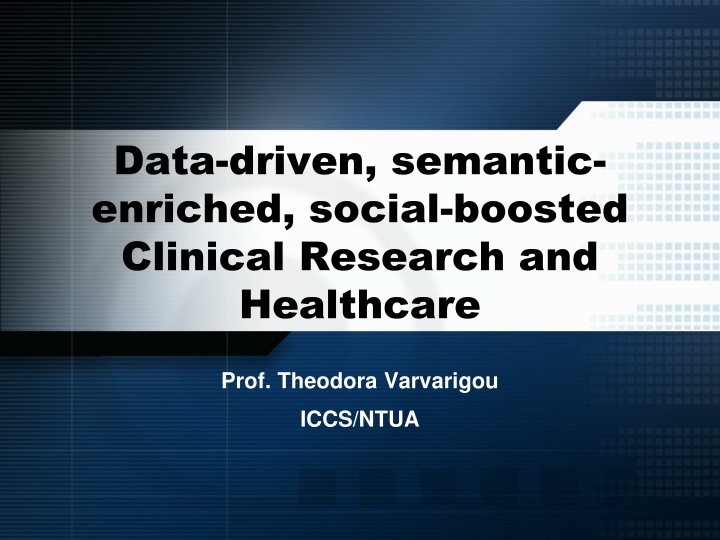
Enhancing Clinical Research with Data-Driven Solutions
Enhance clinical research and healthcare with data-driven approaches and social-boosted strategies. Learn about PONTE Landscape, Patient Recruitment challenges, and the PONTE platform's aim to improve patient recruitment processes and drug repositioning clinical trials using advanced technologies.
Download Presentation

Please find below an Image/Link to download the presentation.
The content on the website is provided AS IS for your information and personal use only. It may not be sold, licensed, or shared on other websites without obtaining consent from the author. If you encounter any issues during the download, it is possible that the publisher has removed the file from their server.
You are allowed to download the files provided on this website for personal or commercial use, subject to the condition that they are used lawfully. All files are the property of their respective owners.
The content on the website is provided AS IS for your information and personal use only. It may not be sold, licensed, or shared on other websites without obtaining consent from the author.
E N D
Presentation Transcript
Data-driven, semantic- enriched, social-boosted Clinical Research and Healthcare Prof. Theodora Varvarigou ICCS/NTUA
PONTE Landscape Patient Recruitment: - 30% - 40% of clinical trial costs - 60% - 80% of trials do not meet their temporal endpoint because of recruitment issues - 30% of trial sites fail to recruit even a single participant - only 15% of clinical trials conclude on schedule 1 compound 5000 compounds 5 compounds 20% possibility of withdrawal or warning Discovery / Preclinical Testing Postmarketing surveillance Regulatory Approval Clinical Trials ~ $1 billion per drug candidate 10-15 years Pharma focuses efforts on Drug Repositioning (40% of R&D resources) $53 billion worth of drugs fell off patent in 2012 $44 billion sales at risk in 2015 due to patent expiration 2
PONTE in a nutshell PONTE aimed at providing a novel platform facilitating: the generation and evaluation of the test of hypothesis in the biomedical domain, the design of a drug repositioning clinicaltrial and offering automatic pre-screening participants Towards this direction the platform exploits and extends Semantic Web technologies in order to offer advanced decision support functionalities to all the above aspects and to achievement semantic interoperability between clinical trials and healthcare patient records for patient recruitment purposes. of potential study 3
PONTE Interface CTP Model Free text semantic search on literature and biomedical data sources Customised and Predefined Queries to Online Data sources Automatically generated suggestions of el. criteria Application of eligibility criteria on patient records for eligible population size estimation during trial design 4 More at http://www.ponte-project.eu/
PONTE Data Infrastructure Linked Data (incl. DrugBank, Diseasome, LinkedCT, KEGG) PubMed and ClinicalTrials.gov The Web Patient Records at Healthcare GoPONTE Is the PONTE semantic search engine Uses Yahoo Boss! Search API for fetching web results and the MeSH, GO and UniProt ontologies for enriching the query and for indexing and annotating the results It searches across abstracts, semi-structured documents, web pages. 5
PONTE results 5 new ontologies (incl. Eligibility Criteria, CTP, Hypothesis, Patient Record, Domain Ontologys) 40 services (incl. information retrieval, automatic generation of research questions and eligible population size) GoPONTE, a semantic search engine with on-the-fly results annotation 1 integrated platform offering the PONTE services The THIRST study on Thyroid Hormone Replacement therapy in patients with ST-Elevation Myocardial Infarction - Zero effort population estimation during trial design at the recruitment sites / Faster go/no-go decisions about sites - Average CTP preparation time in half through direct literature linking, population size estimations and decision support - Over 50% of eligibility criteria of completed drug repositioning clinical trials were suggested by the platform - More than 80% of the CTP parameters were semantically linked with literature for direct semantic searches - 84% of eligibility criteria can be expressed through the El. Criteria Ontology in a machine processable way Summary of the ratio of the relevant results retrieved compared to the full list of results retrieved 6
PONTE Tagaris, A., Chondrogiannis, E., Andronikou, V., Tsatsaronis, G., Mourtzoukos, K., Roumier, J., Matskanis, N., Schroeder, M., Massonet, P., Varvarigou, T. (2012) Semantic Interoperability between Clinical Research and Healthcare: the PONTE approach, Semantic Interoperability in Medical Informatics (SIMI2012) Workshop co-located with the ESWC2012. Roumier, J., Liebman, M., Tsatsaronis, G., Matskanis, N., Tagaris, A., Mourtzoukos, K., Chondrogiannis, E., Andronikou, V. , Massonet, P., Schroeder, M. (2012) Semantically-assisted Hypothesis Validation in Clinical Research, e-Challenges e2012 Conference. Chondrogiannis, E., Andronikou, V., Mourtzoukos, K., Tagaris, T., Varvarigou, T. (2012) A novel Query Rewriting Mechanism for Semantically interlinking Clinical Research with Electronic Health Records, International Conference on Web Intelligence, Mining and Semantics, WIMS 12. Chondrogiannis, T., Matskanis, N., Roumier, J., Andronikou, V., Massonet, Ph., (2011). Enabling semantic interlinking of medical data sources and EHRs for clinical research purposes, eChallenges e-2011 Conference. Andronikou, V., Karanastasis, E., Chondrogiannis, T., Tserpes, K., Varvarigou, T. (2010). Semantically-enabled Intelligent Patient Recruitment in Clinical Trials. 5th International Conference on P2P, Parallel, Grid, Cloud and Internet Computing (3GPCIC 2010), November 4-6, 2010, Fukuoka Institute of Technology, Fukuoka, Japan, IEEE Conference Publishing Services. Tagaris, A., Andronikou, V., Chondrogiannis, E., Tsatsaronis, G., Schroeder, M., Varvarigou, T. and Koutsouris, D. (2014), Exploiting Ontology based search and EHR Interoperability to facilitate Clinical Trial Design, In Dionysios-Dimitrios Koutsouris, Athina A. Lazakidou, Concepts and Trends in Healthcare Information Systems, Annals of Information Systems Volume 16, 2014, pp 21-4 Tagaris, A., Andronikou, V., Karanastasis, E., Chondrogiannis, E., Tsirmpas, H., Varvarigou, T. and Koutsouris (2014) PAT: An intelligent authoring tool for facilitating clinical trial design, 25th European Medical Informatics Conference - MIE2014. Matskanis, N., Andronikou, V., Massonet, P. Mourtzoukos, K., Roumier, J (2012) A Linked Data Approach for Querying Heterogeneous Sources, KEOD 2012 in IC3K (International Joint Conference on Knowledge Discovery, Knowledge Engineering and Knowledge Management). Andronikou, V., Xefteris, S., Varvarigou, T. (2012) A Novel, Algorithm metadata-aware Architecture for Biometric Systems, IEEE Workshop on Biometric Measurements and Systems for Security and Medical Applications, 2012. Tsatsaronis, G., Mourtzoukos, K., Andronikou, V., T., Varlamis, I., Schroeder, M., Varvarigou, T., Koutsouris, D., Matskanis, N. (2012) PONTE: A Context-Aware Approach for Automated Clinical Trial Protocol Design, 38th International Conference on Very Large Databases, VLDB-2012. Tagaris, 7
OpenScienceLink Landscape No universal well-structured repositories of scientific and research data for experimentation and benchmarking of pertinent research works in a given thematic area Poor linking of research with data journals and open access datasets Waste on resources due to research duplication and limited access to data Peer Review Processes remain fragmented, lengthy, biased and in several cases weak and inefficient Reviewers are still equipped with only few tools and need to perform time- consuming, incomplete searches across global literature Current evaluation metrics and systems do not fully reflect the actual quality, novelty and impact of the published work The dynamics of the field, the research work and the researcher are not taken into consideration Limited results of science in dealing with great challenges, such as poverty, climate change, unemployment, social exclusion, which aim at a healthy and productive population 8
The OpenScienceLink in a nutshell OpenScienceLink exploits the open access trend and resources in the scientific world coupled with recent advances in the social analytics and Semantic Web for facilitating addressing the above problems, while also enabling a range of new business models for several stakeholders in the scientific publishing and academic value chains. 9 More at http://opensciencelink.eu/
OpenScienceLink Output One integrated platform incorporating Semantic Web and social analytics technologies for the provision of 5 (five) pilot services: #1: Data journals development based on the OpenScienceLink model for scientific datasets #2: Novel open, semantically-assisted peer review process #3: Research Trends Detection and Analysis #4: Dynamic researchers collaboration based on non-declared, semantically- inferred relationships #5: Scientific field-aware, productivity- and impact-oriented enhanced research evaluation services 10
Current OpenScienceLink Results (1/2) OpenScore: A new evaluation metric which uniquely incorporates scientific output aspects such as work volume, thematic breadth, career timeline and linking with scientific community High correlation with existing evaluation metrics Automatic Abbreviations expansion mechanism: It detects abbreviations along with their meaning regardless of whether their long form is provided in the document or not 95% success rate in detection of true meaning of abbreviations in online biomedical documents (ongoing) Trends detection: Temporal analysis of: Social networks activity for detection of potentially new topics Biomedical concepts across literature with particular focus on the ones of low but rising occurence 11
Current OpenScienceLink Results (2/2) Collaborations suggestion service: Provision of recommendations which are relevant to the expert s topic/domain and are not part of his existing collaborations Correctness of implicitly identified relationships among researchers: >= 60% Biomedical Data Journal: An open access journal aiming to facilitate the presentation, validation, use, and re-use of datasets, with focus on publishing biomedical datasets that can serve as a source for simulation and computational modelling of diseases and biological processes Implements the OpenScienceLink model for datasets and allows the publisher to exploit the platform trends detection and analysis services Publisher: PROCON 12
OpenScienceLink Chondrogiannis, E., Andronikou, V., Karanastasis, E., Varvarigou, T.: An Advanced Query and Result Rewriting Mechanism for Information Retrieval Purposes from RDF datasources. Accepted for publication in the International Conference on Knowledge Engineering and Semantic Web (KESW-2015), Moscow, Russia (2015). Paper will be published by Springer in CCIS 518 proceedings. Chondrogiannis, E., Karanastasis, E., Andronikou, V., Varvarigou, T.: Building a Repository for Inferring the Meaning of Abbreviations used in Clinical Studies. Accepted for publication in the 2nd International Conference on Artificial Intelligence(ICOAI 2015), Amsterdam, Netherlands (2015). Paper will be published in Journal of Computers (JCP, ISSN: 1796-203X) Karanastasis, Tsatsaronis, G., Eisinger, D., Petrova, A. The OpenScienceLink architecture for novel services exploiting open access data in the biomedical domain, 18th Panhellenic Conference on Informatics, PCI2014, 02-04 October 2014. Chondrogiannis, E., Andronikou, Varvarigou, T.: An intelligent ontology alignment tool dealing with complicated mismatches. In: Proceedings of the 7th International Workshop on Semantic Web Applications and Tools for Life Sciences, Berlin, Germany (2014) Chondrogiannis, E., Andronikou, Varvarigou, T.: A Novel Framework for User-Friendly Ontology- Mediated Access to Relational Databases, World Academy of Science, Engineering and Technology (WASET) International Journal of Computer, Electrical, Automation, Control and Information Engineering. Vol. 9(3) (2015). Chondrogiannis, E., Andronikou, Varvarigou, T.: Meaning Inference of Abbreviations Appearing in Clinical Studies. In: Proceedings of the 2015 Symposium on Languages, Applications and Technologies (SLATE-15), Madrid, Spain (2015). E., Andronikou, V., Chondrogiannis, E., V., Karanastasis, E., V., Karanastasis, E., V., Karanastasis, E., 13
BIGGER: The main idea BIGGER aims at exploiting big data technologies applied on a variety of heterogeneous, content- and context-variable data sources for assessing the following question: How to incorporate public health issues in policies across the public sector (such as transportation, urban planning, labor, insurance, education) in order to allow for prompt response in cases of infectious diseases outbreaks and robust, effective policy making in cases of non-communicable diseases? 14
The BIGGER vision Health Labor Insurance Environmental Urban Planning Transportation Farming, Nutrition Healthcare Patient Data Knowledge Bases The BIGGER Platform Social Networks Mobile Applications / Sensors (Health, Lifestyle, Environment, ) Farming, Nutrition Environmental Labor Urban Planning Transportation Insurance Health 15
The BIGGER platform Policy Review Policy Modification Policy Formulation Policy Policy Specification Language Policy Verification Communication Public Health Alerts Public Health Risk Assessment Spatiotemporal Disease Dev Forecast Policy Simulation Models (incl. disease, community, etc) Mobile Apps Sensors (Health, Lifestyle, Environment, ) Knowledge Discovery Prediction Engine Pattern Recognition Feature Extraction Knowledge Bases (incl. diseases, genetics,..) Healthcare Patient Data Temporal Analytics Spatial Analytics Social Analytics Text Analytics Data Confidence Social Networks Data Security & Privacy Data Lifecycle Management Data Quality Management 16
BIGGER Pilots Pilot #1: Short term public health policy making requiring prompt response. Driven by the continuously increasing prevalence and incidence of communicable diseases due to rising numbers of immigrants and the financial crisis, this pilot will focus on an infectious disease, and more specifically early identification of its signs and their estimated spatio-temporal spreading. Pilot #2: Long term public health-driven cross-sectorial policy making on CVD for disease and disease worsening prevention. As preventing cardiovascular disease is not only about better medical treatment, but also about improving access to healthier foods and creating environments that encourage physical activity, this pilot will focus on policy development for CVD prevention and stabilisation. 17
Potential Collaboration To use anonymised, annotated (with contextual information) health and lifestyle datasets (both already collected and real- time generated ones) collected by the applications as part of the BIGGER Data Infrastructure To improve content annotation in collected data for the latter to serve the BIGGER purposes To launch a new study in ResearchKit for supporting the Pilot #2 To develop a DREAM Challenge for researchers to compete in offering public sector policy models on top of or supplementing the ones to be incorporated in the BIGGER platform 18

